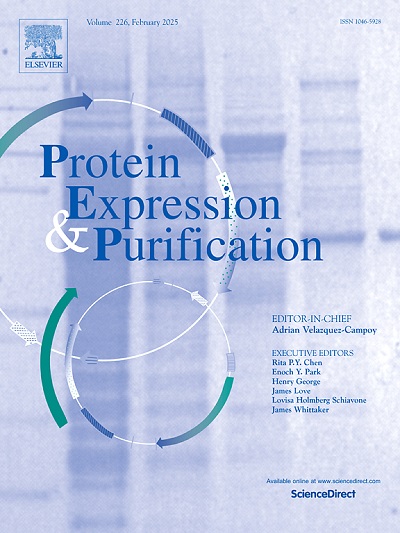从模式植物拟南芥中异源表达和纯化谷氨酸脱羧酶-1:通过硫醇内肽酶活性鉴定体外截短酶的特性。
IF 1.2
4区 生物学
Q4 BIOCHEMICAL RESEARCH METHODS
引用次数: 0
摘要
植物谷氨酸脱羧酶(GAD)是一种由 Ca2+ -钙调蛋白(CaM)激活的酶,它产生γ-氨基丁酸(GABA),是 GABA 分流的第一步。我们之前的研究证实,向模式植物拟南芥的缺∏细胞培养物重新补充∏后,AtGAD1(AT5G17330)的多个 N 端丝氨酸残基会发生体内磷酸化。目前研究的目的是在大肠杆菌中表达重组 AtGAD1(rAtGAD1)后对其进行纯化,以便研究磷酸化对其动力学特性的影响。然而,在纯化过程中,59 kDa rAtGAD1 亚基 C 端约 5 kDa 的多肽发生了体外蛋白水解截短。免疫印迹表明,我们测试过的大多数蛋白酶抑制剂或混合抑制剂都不能有效抑制这种部分 rAtGAD1 蛋白水解。虽然硫醇修饰剂 N-乙基马来酰亚胺或 2,2-二吡啶基二硫化物能抑制 rAtGAD1 的蛋白水解,但它们也会削弱其 GAD 活性。这表明催化作用需要一个重要的 -SH 基团,而且 rAtGAD1 易于被大肠杆菌半胱氨酸内肽酶或可能通过自体蛋白水解活性部分降解。加入外源 Ca2+/CaM 有助于纯化未被蛋白水解的 rAtGAD1,在最佳 pH 值为 5.8 时,rAtGAD1 的特异性活性为 27(产生的 GABA μmol/mg),而在 pH 值为 7.3 时,Ca2+/CaM 可将其激活约 3 倍。相比之下,纯化的部分蛋白水解的 rAtGAD1 在两种 pH 值下的活性都要低 40%,在 pH 7.3 时仅被 Ca2+/CaM 激活 2 倍。这些结果表明,在对纯化的调节酶进行动力学研究之前,需要诊断和防止部分蛋白水解。本文章由计算机程序翻译,如有差异,请以英文原文为准。
Heterologous expression and purification of glutamate decarboxylase-1 from the model plant Arabidopsis thaliana: Characterization of the enzyme's in vitro truncation by thiol endopeptidase activity
Plant glutamate decarboxylase (GAD) is a Ca2+-calmodulin (CaM) activated enzyme that produces γ-aminobutyrate (GABA) as the first committed step of the GABA shunt. Our prior research established that in vivo phosphorylation of AtGAD1 (AT5G17330) occurs at multiple N-terminal serine residues following Pi resupply to Pi-starved cell cultures of the model plant Arabidopsis thaliana. The aim of the current investigation was to purify recombinant AtGAD1 (rAtGAD1) following its expression in Escherichia coli to facilitate studies of the impact of phosphorylation on its kinetic properties. However, in vitro proteolytic truncation of an approximate 5 kDa polypeptide from the C-terminus of 59 kDa rAtGAD1 subunits occurred during purification. Immunoblotting demonstrated that most protease inhibitors or cocktails that we tested were ineffective in suppressing this partial rAtGAD1 proteolysis. Although the thiol modifiers N-ethylmaleimide or 2,2-dipyridyl disulfide negated rAtGAD1 proteolysis, they also abolished its GAD activity. This indicates that an essential -SH group is needed for catalysis, and that rAtGAD1 is susceptible to partial degradation either by an E. coli cysteine endopeptidase, or possibly via autoproteolytic activity. The inclusion of exogenous Ca2+/CaM facilitated the purification of non-proteolyzed rAtGAD1 to a specific activity of 27 (μmol GABA produced/mg) at optimal pH 5.8, while exhibiting an approximate 3-fold activation by Ca2+/CaM at pH 7.3. By contrast, the purified partially proteolyzed rAtGAD1 was >40 % less active at both pH values, and only activated 2-fold by Ca2+/CaM at pH 7.3. These results emphasize the need to diagnose and prevent partial proteolysis before conducting kinetic studies of purified regulatory enzymes.
求助全文
通过发布文献求助,成功后即可免费获取论文全文。
去求助
来源期刊

Protein expression and purification
生物-生化研究方法
CiteScore
3.70
自引率
6.20%
发文量
120
审稿时长
32 days
期刊介绍:
Protein Expression and Purification is an international journal providing a forum for the dissemination of new information on protein expression, extraction, purification, characterization, and/or applications using conventional biochemical and/or modern molecular biological approaches and methods, which are of broad interest to the field. The journal does not typically publish repetitive examples of protein expression and purification involving standard, well-established, methods. However, exceptions might include studies on important and/or difficult to express and/or purify proteins and/or studies that include extensive protein characterization, which provide new, previously unpublished information.
 求助内容:
求助内容: 应助结果提醒方式:
应助结果提醒方式:


